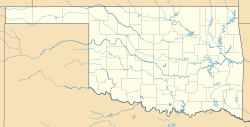Wheelock Church facts for kids
Quick facts for kids |
|
|
Wheelock Church
|
|
| Nearest city | Millerton, Oklahoma |
|---|---|
| Area | 5 acres (2.0 ha) |
| Built | 1846 |
| NRHP reference No. | 72001464 |
| Added to NRHP | November 9, 1972 |
Wheelock Church, also known as Wheelock Mission Church, is a very old church building. It is located in Millerton, Oklahoma, in McCurtain County, Oklahoma. This stone church was built between 1845 and 1846. It is the oldest church building still standing in Oklahoma. It also has the oldest church group in the Choctaw Nation. The church was added to the National Register of Historic Places in 1972. This means it is a special place worth protecting.
Contents
The Story of Wheelock Church
The church group started in 1832. For a while, people met outdoors under a big oak tree. They sat on logs arranged in rows. Reverend Alfred Wright used an upside-down barrel as his pulpit. He gave his first sermon there on December 9, 1832.
In 1832, Reverend Wright also built a small log cabin church. He built a larger log house for his family. He added a big room to this house. His wife, Harriet Bunce Wright, and a teacher named Anna Burnham taught local Choctaw children there. This was a day school that ran until 1839. Later, this school became the Wheelock Academy, a boarding school. The Choctaw Council approved it as a girls' school in 1842.
Building the Stone Church
The new stone church building was started in 1845. It was finished in 1846. People donated money to build it. Many volunteers, mostly Choctaw people, helped build it. The walls are very thick, about 20 inches (0.5 meters) wide. The main floor and balcony have a curved ceiling.
The church is about 40 feet (12 meters) by 50 feet (15 meters) in size. Its tall steeple reaches 35 feet (11 meters) high. Reverend Wright liked the saying "Jehovah Jireh," which means "the Lord will provide." This saying was carved into the front of the church. In 1866, a fire damaged the church. The roof was not fixed until 1884.
The Wright Family's Legacy
Reverend Wright was often away from the church. He was the only person in the area trained as a doctor. He would ride out to help anyone who was sick. This made his own health worse. He had problems like fevers and a heart issue. He passed away on March 31, 1853. As he wished, he was buried in the Wheelock cemetery.
Harriet, his wife, tried to keep the mission and school going. But her own health started to fail about a year after Alfred's death. She had to leave the area and go live with relatives back east. She passed away in Madison, Florida, on October 3, 1863. She was buried there.
New Leadership and Changes
The American Board of Missionaries sent Reverend John Edwards to take over from Reverend Wright. John Libby came as Edwards' helper. In 1861, the Choctaw Nation joined the Confederate States of America during the American Civil War. Because of this, the mission board told Edwards to leave. He went back North.
Edwards moved to San Francisco, California, in 1861. He taught there for two years. Then he moved to Oakland, California. He worked as a minister for different churches for 20 years. In 1882, he returned to work with the Choctaw people. He first worked in Atoka, then came back to Wheelock. He reopened the academy in 1884. He was the school's leader until 1895. After that, the Choctaw Nation took over the school. In 1896, he went back to San Jose, California. He stayed there until he passed away on December 18, 1903.
The Church's Final Year of Regular Services
Reverend Evan B. Evans came to Wheelock as a temporary minister in 1897. By that time, there were only 60 church members. Most of them were students at the school who lived far from Wheelock. The students were often away from church for much of the year. So, regular church services at Wheelock stopped at the end of that year.
See also
- Wheelock Academy
- Oldest churches in the United States
- Oldest buildings in Oklahoma



